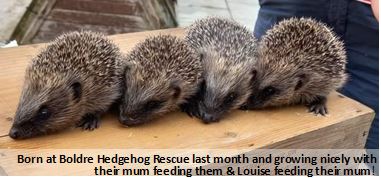
When 3 hoglets were abandoned at the bottom of my garden covered in flies laying eggs on them, I had to help them. They were cold and hungry. Eyebrow tweezers removed the fly eggs. Next a hot water bottle warmed them up, cat meat liquidised gave them their first feed with a syringe.
While they slept I researched caring for hoglets. Hoglets are born with their eyes and ears closed. Need feeding every 2-3 hours. Must be kept warm. So they slept by my bed.
A log basket with blankets would be their nest, feeding with a syringe until their eyes opened. They quickly learned how to climb out of the log basket. I came home one day and found them eating the cats food in the kitchen. That’s when feeding themselves started. It was messy. They had a bath after each feed. Eventually Wriggle, Russell and Fidget grew big enough to explore outside, supervised. I provided leaf filled little houses on the patio and fed them every evening until they decided to wander off when big enough as wild hedgehogs should.
Several years later I decided to learn to care for sick hedgehogs. I thought 2 or 3 would be about right. Vale Wildlife Hospital in Gloucester ran a Basic 1st Aid, Care and Rehabilitation of Hedgehogs 1 day course. I paid, completed the course, received a certificate, a booklet covering the essential information and was ready for a sick hedgehog.
I informed local vets of my new qualification and started receiving hedgehogs.
Hedgehogs are the most difficult wild animal to look after we were told on the hedgehog course. They curl up so you have to be patient to examine them. They get lungworm from eating snails and slugs, their least favourite food. They get ticks, fleas, ringworm, maggots. They get stuck in netting, sleep in bonfires, fall into drains, ditches, ponds, sleep in long grass where strimmer’s are used. Nests are disturbed, hoglets are abandoned by mothers. They suffer from dog attacks, dehydration and starvation, poisoning, traffic accidents and get stuck in rat traps. They get Balloon Syndrome I discovered this on Christmas day when a hedgehog that hadn’t moved in a garden for 24 hours was brought to me by a local man. Internet info was helpful.
I soon received so many hedgehogs, mainly from members of the public, I’ve converted my garage to a hogspital and have dedicated volunteers every morning cleaning out, weighing and feeding the recovering patients. Intensive care is in my bungalow. New arrivals and hoglets need warmth and constant attention.
There are secure areas in my garden where the hedgehogs learn to forage before they can go back into the wild.
To help hedgehogs in gardens, they need gaps under fences, wild areas, water dishes, log piles, care when gardening, no slug pellets or rat poison at ground level. They particularly like nesting under decking or sheds.
Feeding stations and hibernation houses are life savers and, with a camera set up to catch their antics, fascinating.
It’s the height of hoglet season now. I have 4 mothers successfully feeding 19 hoglets between them. I’m syringe feeding 3 orphans at regular intervals. There are also several hedgehogs in different stages of recovery here. I have access to a local 24/7 vet. During gardening season I visit them often with casualties.
I rely on donations to fund the rescue and never turn away a sick, injured or orphan hedgehog.
https://www.facebook.com/eastboldrehedgehogrescue/











